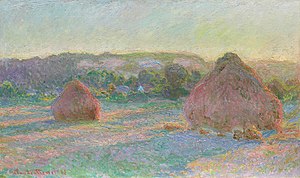| Wheatstacks (End of Summer) | |
|---|---|
 | |
| Artist | Claude Monet |
| Year | 1890–91 |
| Medium | Oil on canvas |
| Dimensions | 60 cm × 100 cm (23+5⁄8 in × 39+3⁄8 in) |
| Location | Art Institute of Chicago, Chicago |
Haystacks is the common English title for a series of impressionist paintings by Claude Monet. The principal subject of each painting in the series is stacks of harvested wheat (or possibly barley or oats: the original French title, Les Meules à Giverny, simply means The Stacks at Giverny). The title refers primarily to a twenty-five canvas series (Wildenstein Index Numbers 1266–1290) which Monet began near the end of the summer of 1890 and continued through the following spring, though Monet also produced five earlier paintings using this same stack subject. A precursor to the series is the 1884 Haystack Near Giverny (Pushkin Museum).
The series is famous for the way in which Monet repeated the same subject to show the differing light and atmosphere at different times of day, across the seasons and in many types of weather.
The series is among Monet's most notable work. The largest Haystacks collections are held at the Musée d'Orsay and Musée Marmottan Monet in Paris, and in the Art Institute of Chicago.[1] Other collections include the Museum of Fine Arts, Boston,[2][3] the Metropolitan Museum and Museum of Modern Art in New York, the National Museum of Western Art in Tokyo,[4] and the Musée de l'Orangerie in Paris. The Art Institute of Chicago collection includes six of the twenty-five Haystacks.[5]
Other museums that hold parts of this series include the Getty Center in Los Angeles,[6] the Hill-Stead Museum in Farmington, Connecticut (which also has one of five from the earlier 1888–89 harvest),[7] the Scottish National Gallery,[8] the Minneapolis Institute of Arts,[9] Kunsthaus Zürich, Tel Aviv Museum of Art and the Shelburne Museum, Vermont.[10] Private collections hold the remaining Haystacks paintings.
- ^ "Claude Monet". The Art Institute of Chicago. Retrieved May 17, 2021.
- ^ "Collection Search Results: Grainstack (Snow Effect)". Museum of Fine Arts, Boston. 2007. Archived from the original on December 5, 2007. Retrieved July 3, 2007.
- ^ "Collection Search Results: Grainstack (Sunset)". Museum of Fine Arts, Boston. 2007. Archived from the original on October 27, 2007. Retrieved July 3, 2007.
- ^ "Country-by-Country List of Museums Holding Originals (Monet)". artofmonet.com. Archived from the original on October 25, 2007. Retrieved October 9, 2007.
- ^ Jill Shaw (2014). "Stacks of Wheat, 1890/91". In Groom, Gloria; Shaw, Jill (eds.). Monet Paintings and Drawings at the Art Institute of Chicago. Art Institute of Chicago. Retrieved February 24, 2017.
- ^ "Explore Art: Artists; Claude Monet; Wheatstacks, Snow Effect, Morning". The Getty Center, Los Angeles. 2010. Archived from the original on August 30, 2011. Retrieved January 26, 2010.
- ^ "Highlights of the Collection (Paintings:Monet)". Hill-Stead Museum. Archived from the original on June 23, 2007. Retrieved July 17, 2007.
- ^ "Collection M: Claude Monet". Retrieved July 3, 2007.
- ^ "Collections > Explore the Collection (Grainstack, Sun in the Mist)". The Minneapolis Institute of Arts. Archived from the original on September 27, 2007. Retrieved July 2, 2007.
- ^ "Collections: Impressionist Paintings (Image 02)". Shelburne Museum. 2005. Archived from the original on August 22, 2007. Retrieved July 2, 2007.